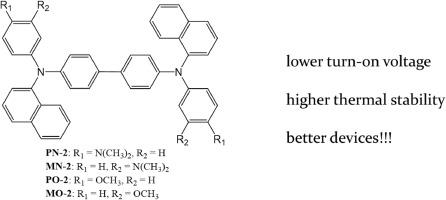New derivatives of N,N′-bis(naphthalen-1-yl)-N,N′-bis(phenyl)benzidine for dopant-free organic light emitting diodes with low turn-on voltages
IF 4.2
3区 材料科学
Q2 MATERIALS SCIENCE, MULTIDISCIPLINARY
引用次数: 0
Abstract
N,N′-bis(naphthalen-1-yl)-N,N′-bis(phenyl)benzidine (NPB) is a hole-transporter widely used in optoelectronic devices due to the low energetic disorder of its layers, high drift mobility of holes and suitable energy levels. In this work, new hole-transporting derivatives of NPB are developed with the aim of achieving lower ionization energies and the smooth transport of holes to the recombination sites of organic light-emitting diodes (OLEDs). Aiming at low turn-on voltages and enhanced efficiency and stability of the devices, electron-donating methoxy and dimethylamine groups are attached to the NPB core. The modification results in the manifestation of intramolecular charge transfer. While NPB is characterized by high crystallinity, the newly synthesized compounds are capable of the formation of molecular glasses. The compounds exhibit higher thermal stability (5 % weight loss at 388–411 °C) compared to that of NPB. The highest hole drift mobility of 1.85 × 10−3 cm2/V × s at the electric field of 2.5 × 105 V/cm was detected for the compound with para-methoxy moieties. A series of doping-free OLEDs were fabricated to test the performance of the compounds as hole-transporting materials. It is demonstrated that turn-on voltages as low as 2.4 V can be achieved for the devices utilizing the layers of the synthesized hole-transporting compounds. Such low turn-on voltages are manifestation of the smooth barrierless charge transport necessary for high efficiency and operational stability of OLED. With another emitter chosen, namely CzPCN, the interface exciplexes between the hole-transporter and emitter were formed highlighting the same ability as for NPB.

新型N,N ' -二(萘-1-基)-N,N ' -二(苯基)联苯胺衍生物用于低导通电压无掺杂有机发光二极管
N,N′-双(萘-1-基)-N,N′-双(苯基)联苯胺(NPB)是一种空穴转运体,由于其层间能量无序性低、空穴漂移迁移率高、能级适宜,被广泛应用于光电子器件中。在这项工作中,开发了新的NPB空穴输运衍生物,目的是实现更低的电离能和空穴到有机发光二极管(oled)重组位点的平滑输运。为了降低器件的导通电压,提高器件的效率和稳定性,在NPB芯上附着给电子的甲氧基和二甲胺基团。这种修饰导致了分子内电荷转移的表现。虽然NPB具有高结晶度的特点,但新合成的化合物能够形成分子玻璃。与NPB相比,该化合物表现出更高的热稳定性(在388-411℃时失重5%)。对甲氧基化合物在2.5 × 105 V/cm电场下的最高空穴漂移迁移率为1.85 × 10−3 cm2/V × s。制备了一系列无掺杂的有机发光二极管,测试了这些化合物作为空穴传输材料的性能。结果表明,利用合成的空穴传输化合物层可以实现低至2.4 V的导通电压。如此低的导通电压是OLED高效率和运行稳定性所必需的平滑无垒电荷输运的表现。当选择另一种发射极(即CzPCN)时,空穴输运子和发射极之间形成了界面杂合体,其能力与NPB相同。
本文章由计算机程序翻译,如有差异,请以英文原文为准。
求助全文
约1分钟内获得全文
求助全文
来源期刊

Optical Materials
工程技术-材料科学:综合
CiteScore
6.60
自引率
12.80%
发文量
1265
审稿时长
38 days
期刊介绍:
Optical Materials has an open access mirror journal Optical Materials: X, sharing the same aims and scope, editorial team, submission system and rigorous peer review.
The purpose of Optical Materials is to provide a means of communication and technology transfer between researchers who are interested in materials for potential device applications. The journal publishes original papers and review articles on the design, synthesis, characterisation and applications of optical materials.
OPTICAL MATERIALS focuses on:
• Optical Properties of Material Systems;
• The Materials Aspects of Optical Phenomena;
• The Materials Aspects of Devices and Applications.
Authors can submit separate research elements describing their data to Data in Brief and methods to Methods X.
 求助内容:
求助内容: 应助结果提醒方式:
应助结果提醒方式:


